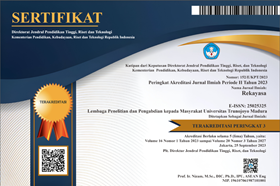Penerapan Sistem Kontrol Adaptif Proportional Integral Derivative (PID) pada Mesin Penimbang Mie dengan Konveyor
Abstract
Indonesia is the second-largest instant noodle consumer in the world after China, with consumption reaching more than 12 billion packs per year. This high demand drives the need for innovation in the production process, especially in the weighing and cutting aspects, which are still carried out manually in small and medium industries. Manual processes not only require more time and energy, but also result in variations in packaging weight that are not uniform and reduce production efficiency. This study aims to design and implement a Proportional Integral Derivative (PID) adaptive control system on a noodle weighing machine with a conveyor. The system was developed using a load cell sensor to measure the noodle dough weight, a servo motor as a cutting actuator, and a DC motor as a conveyor drive, all of which are controlled by an Arduino ATmega 2560 microcontroller. The research methodology includes mechanical design, electronic design, control system programming, sensor calibration, and performance testing. The test results show that the system is able to produce noodle portions with a target weight of 50 grams consistently. The prototype has conveyor dimensions of 100×20×8 cm with a speed of 26 cm/ms, controlled using tuned PID parameters (Kp=1.5; Ki=1; Kd=1.7). From 20 trials, the system produced an average error of 0.75% and a success rate of 99.25%. Thus, the application of the PID adaptive control system has been proven to improve weighing precision, conveyor speed stability, and production efficiency. This innovation is expected to be a simple and affordable solution to support the automation of small and medium industries in Indonesia in facing increasingly fierce food market competition.
Keywords
Full Text:
PDF (Bahasa Indonesia)References
Chyzhykov, D., Widziewicz-Rzońca, K., Błaszczak, M., Rogula-Kopiec, P., & Słaby, K. (2023). Automatic weighing system vs. manual weighing precision comparison in PM-loaded filter measurements under different humidity conditions. Environmental Monitoring and Assessment, 195(11), 1393. https://doi.org/10.1007/s10661-023-11939-7
Galina, M. (2024). Design and Implementation of Home Industrial-Based Automatic Granulated Food Weighing Machine. JURNAL INFOTEL, 16(3). https://doi.org/10.20895/infotel.v16i3.1168
Guner, C., Basdogan, H., & Eris, A. (2024). Consumption Behaviors and Factors Influencing Preferences for Instant Noodles: The Case of Turkiye. International Journal of Gastronomy Research, 3(2), 54–61. https://doi.org/10.56479/ijgr-44
Jambormias, M., Faridah, D. N., Muhandri, T., & Polnaya, F. J. (2025). Karakteristik fisikokimia tepung lima varietas lokal gembili dan potensinya dalam pengembangan mi bebas gluten. Agrointek : Jurnal Teknologi Industri Pertanian, 19(2), 402–412. https://doi.org/10.21107/agrointek.v19i2.25571
Kesiananda, T. A., & Ningrum, D. N. A. (2023). The Relationship Between Instant Noodle Consumption and the Proportion of Hypertension Aged >18 Years According to Provinces in Indonesia. Proceeding.Unnes. https://doi.org/https://doi.org/10.15294/icohespe.2025.4160
Kılınç, I., Nasyiruddin, R., Ramandani, A., & Kılınç, B. (2025). Innovative Manufacturing of Fish-Enriched Instant Noodles: A Perspective of Circular Economy and Sustainability Approach. 1, 38–49.
Komarudin, N. A., Fahrunnisa, F., & Afgani, C. A. (2025). Evaluation of Rural Community Adaptation and Mitigation to Climate Change Using a Discrete Choice Experiment. Jurnal Agroekoteknologi Terapan (Applied Agroecotechnology Journal), 6(1), 74–85.
Kusumo, S. H. H., Siswadi, S., & Setyono, G. (2022). Pemberdayaan Mesin Teknologi Tepat Guna Pembuat Dan Pengering Mie Pipih Berkapasitas 5kg/Jam Untuk Peningkatan Produksi UKM Di Gresik. Pengabdian Masyarakat Dan Inovasi Teknologi (DIMASTEK), 1(01), 23–28. https://doi.org/10.38156/dimastek.v1i01.19
Madhavan, M., Sharafuddin, M. A., & Wangtueai, S. (2024). Measuring the Industry 5.0-Readiness Level of SMEs Using Industry 1.0–5.0 Practices: The Case of the Seafood Processing Industry. Sustainability, 16(5), 2205. https://doi.org/10.3390/su16052205
Moraes, T. A., da Silva, M. T., & Euzébio, T. A. M. (2024). Delay Compensation in a Feeder–Conveyor System Using the Smith Predictor: A Case Study in an Iron Ore Processing Plant. Sensors, 24(12), 3870. https://doi.org/10.3390/s24123870
Putri, M. D. I., Ma’arif, A., & Puriyanto, R. D. (2022). Pengendali Kecepatan Sudut Motor DC Menggunakan Kontrol PID dan Tuning Ziegler Nichols. Techno (Jurnal Fakultas Teknik, Universitas Muhammadiyah Purwokerto), 23(1), 9–18.
Sudirman, I. D., Astuty, E., & Aryanto, R. (2025). Enhancing Digital Technology Adoption in SMEs Through Sustainable Resilience Strategy: Examining the Role of Entrepreneurial Orientation and Competencies. Journal of Small Business Strategy, 35(1). https://doi.org/10.53703/001c.124907
Susanto, A., & Septian, H. (2024). Mengapa Mie instan di Indonesia Menjadi Konsumen Terbesar di Dunia? In jurno.id. https://jurno.id/jurnopedia/mengapa-mie-instan-di-indonesia-menjadi-konsumen-terbesar-di-dunia
Thin, P. P., Win, H. H., Soe, A. K., & Latt, A. K. (2024). Development and testing of a semi-automatic machine for making noodles. Advanced Engineering Letters, 3(2), 64–75. https://doi.org/10.46793/adeletters.2024.3.2.3
Toiba, H., Noor, A. Y. M., Rahman, M. S., Hartono, A., Asmara, R., & Retnoningsih, D. (2023). Consumers’ Preference and Future Consideration Toward Organic Instant Noodles: Evidence from Indonesia. Agris On-Line Papers in Economics and Informatics, 15(1), 127–137. https://doi.org/10.7160/aol.2023.150110
Venkataramanan, V., Verma, S., Samant, A., & Mehta, N. (2023). Automatic batch weighing and discharge system using NI LabVIEW and auger mechanism. E-Prime - Advances in Electrical Engineering, Electronics and Energy, 6, 100322. https://doi.org/10.1016/j.prime.2023.100322
Wardhana, A. S., Hamdani, C. N., Dewi, A. K., Ravy, J. U., Aji, F., & Hendrawati, D. (2023). Design of feed rate control system on loss in weight feeder using programmable logic controller. Jurnal Polimesin, 21(1), 93–100.
Waseem, M., Bhatta, K., Li, C., Haider, N., & Chang, Q. (2024). Energy-efficient and quality-focused control of conveyor belt dryers in petrochemical production. Npj Advanced Manufacturing, 1(1), 10. https://doi.org/10.1038/s44334-024-00010-z
(WINA), W. I. N. A. (2025). Demand Rankings. In World Instant Noodles Association (WINA). https://instantnoodles.org/en/noodles/demand/table/?utm_source=chatgpt.com
Yang, C., Chen, B., Bu, L., Zhou, L., & Ma, L. (2023). Low-order dynamical model and distributed coordinated model predictive control for multi-stage belt conveyor systems. Journal of Process Control, 124, 83–91. https://doi.org/10.1016/j.jprocont.2023.02.010
Zare, L., Ali, M. Ben, Rauch, E., & Matt, D. T. (2025). Navigating challenges of small and medium-sized enterprises in the Era of Industry 5.0. Results in Engineering, 27, 106457. https://doi.org/10.1016/j.rineng.2025.106457
DOI
https://doi.org/10.21107/rekayasa.v18i2.31610Metrics
Refbacks
- There are currently no refbacks.
Copyright (c) 2025 Ach dafid, Faikul Umam, Hairil Budiarto

This work is licensed under a Creative Commons Attribution-ShareAlike 4.0 International License.
























